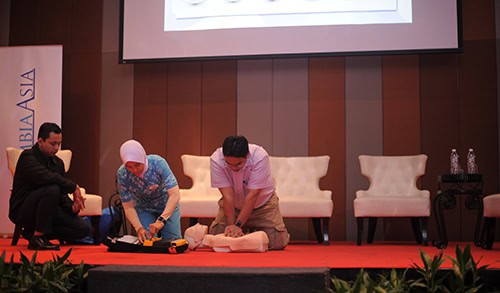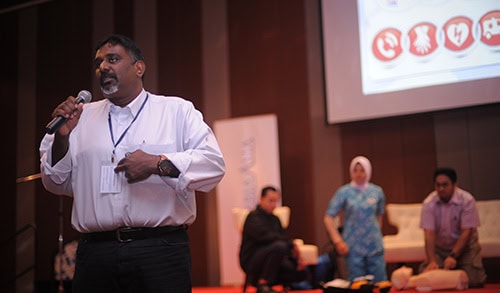Would you know what to do if a loved one collapsed in front of you and showed no sign of life? If you find yourself in such a situation, it could mean the person’s heart has stopped beating and that he/she could be experiencing what doctors call sudden cardiac arrest (SCA). If you think that’s bad news, that’s only the half of it. Before you can fully absorb what’s happening, you have to spring into action because you have only four minutes to save the person’s life by performing cardiopulmonary resuscitation (CPR).
Almost everyone has heard of CPR. You would have heard it being discussed in school or probably seen someone perform the procedure on crime shows on TV. But the question is, do you know what it takes to save someone’s life with CPR?
In most SCA cases, proper application of this simple but vital skill could be the difference between life and death. Statistics indicate that about 80 per cent of SCA cases occur either at home or public spaces. In such a scenario, the person nearest to the victim is likely to be a relative, friend or passer-by with no medical expertise. But if the person present at the scene is able to perform CPR on the victim promptly, the latter’s chance of survival is significantly increased. Indeed, learning how to effectively administer CPR means you could one day save the life of a loved one.

Position hands over sternum and begin chest compressions while the second-aider sets up the AED machine. It’s always good to have someone on standby to take over chest compressions after two minutes.
Columbia Asia Hospital Malaysia consultant emergency physician and regional emergency services coordinator Dr Terence Leslie de Silva said SCA is a condition when the heart suddenly and unexpectedly stops beating. There are many causes of cardiac arrest, ranging from existing heart arrhythmia to being hit in the chest with a baseball. Regardless of the underlying condition, without CPR, most people experiencing SCA won’t survive, and with every minute CPR is delayed, the survival rate declines.
“CPR only works when the heart suddenly stops beating, most often because of a cardiac condition or heart attack. The heart’s function is to pump blood into vital organs such as the brain and kidneys, and in the case of a cardiac arrest, CPR is urgently needed to restore blood flow from the heart to the vital organs,” he continued.
By doing CPR, he added, the victim’s heartbeat is stimulated, restoring blood flow and oxygenation to the body’s system until medical professionals arrive at the scene. “Chest compressions force the heart to continue pumping, essentially serving as the electrical signal that keeps the heart beating.”

De Silva says time is of the essence when treating a cardiac arrest victim. — Photo from Columbia Asia
De Silva stressed that time is of the essence when treating a cardiac arrest victim. “Once the heart stops beating, the blood circulation stops and if not treated within four minutes, it will cause irreversible damage to the victim’s brain cells shortly after oxygen deprivation.”
Apart from that, de Silva said CPR helps to prolong any abnormal rhythm there is in the victim’s heart. “Most times, when people have a heart attack or SCA, the heart starts to brillate instead of beating in proper rhythm.”
He also pointed out that it’s because of this brillation that the Automatic External De brillator (AED) machine comes in handy when dealing with SCA cases.
“In many developed countries around the world, you can easily nd AED devices in airports, offices, shopping malls and public places all within a distance of four minutes,” he added.
De Silva explained that the AED machine is a life-saving equipment that goes hand in hand with CPR; it is used to jumpstart the heart in the event of SCA. “These portable shock devices automatically detect the abnormal heart rhythm and treat it through de brillation.”
Each machince is equipped with straightforward audio and visual commands, making it easy for any by stander to use.
Because SCA can occur to anyone at any time, de Silva said it is crucial for everyone to know how to correctly perform CPR.
In the past, some people were reluctant to perform CPR on a SCA victim because it involved mouth-to-mouth resuscitation, he noted. But the guideline for performing CPR changed in 2010, allowing those uncomfortable or who have not received proper training to attempt hands-only CPR until qualified paramedics arrive at the scene.
The sequence of basic life support as explained by de Silva
1. Danger
If someone appears to be unconscious, survey the area first and check for possible risks to the victim and yourself. Although it is best to begin CPR as quickly as possible, the first-aider needs to ensure that he will be safe while performing the procedure.
2. Response
Once you have approached the victim, determine if CPR is necessary by assessing the person’s responses. Ask loudly if the person is okay or gently shake the person to examine responsiveness. If there is no response, check for signs of life by assessing the victim’s pulse.
Place your finger two finger breadths away (either to the left or right) from the person’s Adam’s apple to feel the pulse. If there’s no pulse, call 999 and you’ll be directed to the medical emergency call centre where a doctor or paramedic will take you through the sequence of CPR while waiting for the ambulance to arrive. Meantime, ask if anyone in the area can provide you with an AED machine.
3. Circulation
Begin chest compressions. Place the heel of your dominant hand over sternum (the hard bone of the chest) – the midpoint between the epigastric region and the base of the neck – and put the other hand on top of the dominant hand. Keep arms straight and push the chest down about two inches deep. Try to do at least 120 compressions in two minutes.
Bear in mind that chest compression is a tiring procedure. Therefore, it’s good to have someone on standby to take over after two minutes.
Once the AED has arrived, stop the chest compressions, switch on the device and attach the pads on the patient’s chest.
The basic life support procedure also includes “Airway” and “Breathing” techniques which de Silva said are best left to qualified paramedics.
This article first appeared in Malay Mail, 22 March 2018
Share:
Was this article helpful?
Share:
Was this article helpful?
Health Packages
Elevate your health with tailored health packages at Columbia Asia Hospital. Take charge of your health journey today.

